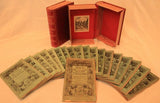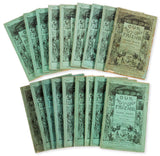Our Mutual Friend in the original 19/20 parts
Author: Charles John Huffam Dickens (1812-1870)
Year: 1864-1965
Publisher: Chapman and Hall
Place: London
Description:
20 parts in 19, as issued. First issue of part 1 without the printer's imprint on front wrapper, wood engraved frontispiece and 39 plates after Marcus Stone by Dalziel and W.T. Green, part 1 lacks Thorley's 4 pages of ads, part 6 lacks Armadale slip and Norton's Pills 4 pages of ads, part 7 with Thorley's Farmer's Almanack duplicated at front of ads, part 14 lacks Mappin Webb & Co. 4 pages of ads., part 18 lacks Norton's Pills and Liverpool & London & Globe ads, but with 8 pages Chapman & Hall ads not called for, part 19/20 with additional 2 ads for John F. Dunn's City Book Mark each 2 pages inserted at front and back, all other slips and advertisements as called for, Octavo (8 3/4" x 5 1/4") bound in original green wrappers. House in two red enclosures with gilt letter to spine and marbled end boards. (Hatton & Cleaver pp.343-370) First edition.
Our Mutual Friend, written in 1864–1865, is the last novel completed by Charles Dickens and is one of his most sophisticated works, combining savage satire with social analysis. It centers on, in the words of critic J Hillis Miller, quoting from the character Bella Wilfer in the book, "money, money, money, and what money can make of life". Most reviewers in the 1860s continued to praise Dickens' skill as a writer in general, but did not review this novel in detail. Some found the plot both too complex and not well laid out. The Times of London found the first few chapters did not draw the reader into the characters. In the 20th century, however, reviewers began to find much to approve in the later novels of Dickens, including Our Mutual Friend. In the late 20th and early 21st centuries, some reviewers suggested that Dickens was, in fact, experimenting with structure, and that the characters considered somewhat flat and not recognized by the contemporary reviewers were meant rather to be true representations of the Victorian working class and the key to understanding the structure of the society depicted by Dickens in the novel.
Condition:
Part 13 with light damp-staining to plates, occasional spotting but generally clean internally, original printed blue wrappers, some occasional light repair or retouching to spines, part 1 upper cover rather creased and soiled with some chipping to head an foot, part 6 with hole to lower wrapper, part 19/20 a little soiled with some chipping, still a very good set generally, preserved in two custom red calf drop-front boxes,











